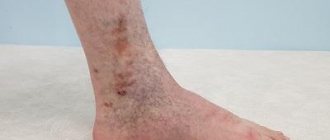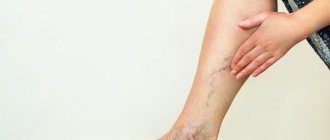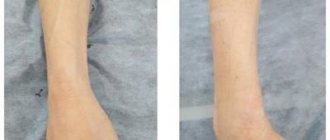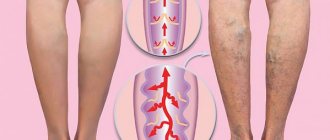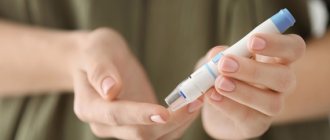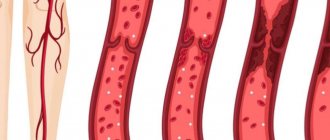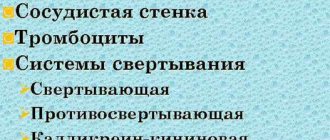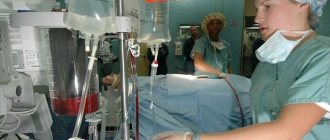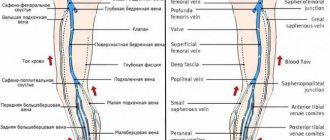Varicose eczema has a second name - stasis dermatitis. Among the elderly, diseases of the lower extremities are common; the most common ailment is varicose veins, as a result of which blood flow in the legs is disrupted, which is what causes this type of eczema.
In essence, eczema is an inflammation of the upper layers of the epidermis, which is characterized by a chronic course. This type of dermatological disease has several subtypes, which can occur for a number of reasons and differ in symptoms.
Causes of varicose eczema
The main reason is a lack of oxygen due to impaired blood flow, which causes poor healing, decreased skin elasticity, and decreased protective functions of the dermis.
In addition, the reasons contributing to the development of varicose eczema have been identified:
- overweight;
- endocrine diseases;
- vascular or heart diseases;
- reduced level of immunity;
- pathologies of veins and blood vessels;
- mechanical damage to the lower extremities;
- pregnancy;
- infectious diseases;
- lack of physical activity;
- operations;
- a history of other dermatological diseases.
Varicose eczema is not contagious, but it has an unpleasant appearance and is often accompanied by unpleasant and sometimes painful sensations, so it is very important to consult a doctor.
Find out more
Symptoms of varicose eczema
Varicose eczema is preceded by the following symptoms: hyperemia and itching of the skin, scales appear on the skin, and sometimes tissue swelling is noted. The following symptoms follow:
- There are bright red spots on the skin that are inflamed.
- A small rash appears in the form of vesicles.
- The vesicles open on their own, this process is accompanied by severe itching, subsequently the patient scratches the affected areas, and ulcers form.
- Swelling is noted.
- Wet areas appear.
- Wet areas dry out, forming crusts, and the skin in these places thickens.
- In the affected areas, pigmentation of the dermis is noted, the skin acquires burgundy shades.
In cases of secondary infection, purulent papules may appear, the disease is accompanied by a burning sensation and pain, and trophic ulcers form (wounds that heal very poorly).
The first stage is accompanied by itching, which may intensify in the evening. The skin takes on a red, shiny tint. Over time, a rash with cloudy contents appears. Pain may occur, this is due to the formation of swelling.
If ignored, the disease progresses, trophic changes appear, and the itching intensifies. The rash enlarges, previous rashes are revealed and weeping areas are noted. Such areas are dangerous because they become gateways for pathogenic microflora to enter.
The predominant number of diseases of varicose eczema is accompanied by infectious lesions. The cyclical nature of this disease leads to changes in the appearance of the dermis. The skin acquires a purple tint, thickens, and as a result, ulcers can form that penetrate into the deep layers of the dermis.
You can see what varicose eczema (stasis dermatitis) looks like in the photo section.
Trophic eczema. Reviews from patients of Dr. Semenov A.Yu.
I have been suffering from varicose veins for 10 years, although I HAVE NOT SUFFERED BEFORE!
I decided to contact the laser surgery center after reading the reviews. Already when trophic eczema appeared on the skin, it was necessary, of course, earlier, but it’s good that not later. I went to the clinic on June 29, 2011, I think that I was lucky to get an initial appointment with Artem Yuryevich Semenov. Sensitive, good-natured and, as time has shown, a professional in his field, made a diagnosis, suggested a course of treatment (radiofrequency ablation +...More details Emil Rustamovich Akhmedzhanov, Moscow, 02/10/2013.
Varicose veins were inherited from me. At the age of 30 I treated myself with sclerotherapy. The veins and bumps were gone and my left leg looked great. After the birth of my second child, the problems with my left leg returned. At first, small bumps appeared, and over time, darkening appeared on the left leg. Then a whole spot grew from a small spot, which turned out to be trophic eczema (((. My leg began to ache from a long walk. I had to constantly use Lyoton. Of course, time was lost, I...More
Tatyana Chertilina, Moscow, 03/01/2017
Varicose eczema in adults
In adults, this type of eczema is more common than in children; women are more susceptible to this disease, this is due to previous pregnancies and wearing high-heeled shoes.
The skin tissues lack oxygen, which makes the dermis more vulnerable, and the recovery processes are slowed down. The disease is not contagious, but it is very difficult to eliminate. Therefore, it is very important to consult a doctor at the first suspicious symptoms.
You should take this disease seriously, because in addition to its unflattering appearance, the disease is dangerous due to complications.
Often, therapy involves a comprehensive approach, which consists of taking pills, applying ointments or creams, and physiotherapy.
Bibliography
- Dakhovsky, A. Skin diseases / A. Dakhovsky, N. Stogova. - M.: Book on Demand, 2011. - 761 p.
- Gadzhimuradov, M. N. Clinical features of Kirle’s disease [Text] / M. N. Gadzhimuradov // Clinical dermatology and venereology. - 2021. - No. 1. - P. 16-19.
- Zudin B.I. Skin and venereal diseases. Textbook. Ed. 2nd, revised and additional - M.: Medicine, 1996, 256 p.
- Sokolova, T. V. Strategy for choosing external therapy for microbial eczema [Text] / T. V. Sokolova, A. P. Malyarchuk, L. A. Safonova // Clinical dermatology and venereology. - 2021. - No. 3. - P. 46-63.
- Therapy of chronic dermatoses [Text]: [conversation with Ph.D. Assoc. department Dermatovenerology of the First Moscow Moscow. honey. University named after I. M. Sechenova T. A. Belousova / interviewed by N. Marchenko] // Medical Council. - 2017. - No. 11. - P. 80-82. 88.
- UVB 311 NM phototherapy for immune-dependent dermatoses [Text]: educational method. allowance / E. S. Ponich [etc.] // Physiotherapist. - 2017. - No. 2. - P. 57-64.
Varicose eczema in children
In children, varicose eczema occurs very rarely; the main cause is blood flow disturbances and valve malfunctions.
The lymph that enters the lower extremities clogs the vessels, slowing down the blood flow, which causes deformation of the vessels and veins, resulting in nodules. The following factors can also cause the development of varicose eczema in children:
- lower limb injuries;
- overweight;
- other dermatitis;
- allergy;
- frequent infections;
- operations on the lower extremities;
- inactive lifestyle;
- hereditary factor.
Varicose eczema occurs in children, as well as in adults. Treatment involves complex therapy.
The disease progresses in stages, the previous signs are the appearance of a rash, the formation of weeping areas.
- Red spots form on the skin and the skin is inflamed.
- A rash appears in the form of small papules or vesicles.
- The vesicles/papules open on their own, this process is accompanied by severe itching, subsequently the patient scratches the affected areas, and ulcers form.
- Tissue swelling is noted.
- Weeping areas appear or, on the contrary, dry skin is noted in the areas where the lesions are localized.
- Wet areas dry out, forming dense crusts, the skin in these places is compacted.
- In the affected areas, pigmentation of the dermis is noted, the skin acquires burgundy and bluish shades.
In cases of secondary infection, purulent papules may appear, the disease is accompanied by a burning sensation and pain, and trophic ulcers form (wounds that heal very poorly).
Often, therapy involves a comprehensive approach, which consists of taking pills, applying ointments or creams, and physiotherapy.
Treatment of varicose eczema
Before starting treatment, it is necessary to carry out a number of diagnostic measures to establish an accurate diagnosis. For this, the dermatologist prescribes:
- scraping of separated skin particles;
- general and biochemical blood test;
- Vascular ultrasound;
- histological examination.
Based on the obtained tests, therapy is prescribed, which involves an integrated approach. If treated promptly, there is a good chance that non-invasive treatments will be sufficient.
Treatment of varicose eczema with folk remedies
To facilitate the course of the disease, you can use traditional methods as an addition to the main drug treatment. Most often, lotions or compresses based on herbs or other natural ingredients are used:
- sagebrush;
- plantain;
- potato;
- burdock;
- aloe;
- calendula;
- chamomile.
Before using any folk method, you must consult your doctor. It is unacceptable to replace basic drug treatment with traditional methods, especially for children.
Treatment of varicose eczema with medications
Treatment of varicose eczema is possible only after an accurate diagnosis has been made by a dermatologist or phlebologist; therapy often involves an integrated approach, which consists of taking pills, applying ointments or creams, and physiotherapy.
Pills:
- phlebotonics – to solve problems associated with venous insufficiency;
- diuretics - to eliminate edema;
- antihistamines - to relieve discomfort (itching) and inflammation of the skin;
- antibiotics - in cases of infections;
- sedatives - to relieve nervous tension;
- vitamin complexes - to maintain immunity levels.
Ointments:
- anti-inflammatory – to relieve swelling and redness in affected areas of the skin;
- venotonics – to improve blood circulation;
- heparin ointments;
- hormonal ointments - to ensure anti-exudative action;
- corticosteroids - to eliminate swelling and inflammation;
- regenerating creams or ointments.
The choice of ointment is determined by the course of the disease; if there are wet areas, ointments with a drying effect (often zinc-based) are needed; if dryness is noted, then emollient ointments are indicated.
Ointments are intended for local action on affected areas, and the main purpose of ointments is to relieve discomfort and sanitation.
Physiotherapy:
- electrophoresis;
- oxygen baths;
- phototherapy, etc.
In combination with drug treatment, physiotherapy is highly effective. Such procedures are prescribed only by a doctor; a specialist prescribes the necessary procedures and their duration, often aimed at improving blood circulation.
Many experts recommend wearing compression garments or bandages that are soaked in solutions.
In cases where therapy is powerless and does not give the desired result, such patients are indicated for surgical intervention to remove veins affected by varicose veins.
Is it worth using folk remedies?
You can find a lot of “folk art” recipes that help with varicose veins and combat its consequences. They contain cabbage leaves, nettles, green tomatoes, butter with garlic and other familiar products.
Some “healers” advise walking barefoot through the dew at dawn, wiping the affected areas of the skin with apple cider vinegar, and applying horseradish leaves to the wounds.
Doctors warn that such treatment will be absolutely useless. Moreover, ignoring drug therapy and doctor’s recommendations provokes rapid progression of the problem. The result will be deep trophic ulcers - bleeding, with purulent filling: a photo of varicose eczema in an advanced stage clearly demonstrates this.
The only thing phlebologists allow is taking infusions with a diuretic effect, which will remove excess fluid from the body and make swelling less pronounced. The following will be useful:
- infusion of lingonberry leaves - 2 tablespoons of dry raw material per 300 ml of boiling water, leave for 1 hour and drink;
- decoction of rose hips - 1 tablespoon per 200 ml of water, boil in a water bath for 5 minutes, leave for 20 minutes and drink;
- bearberry infusion - the raw material is sold at the pharmacy, 1 teaspoon per 300 ml of boiling water will be enough.
Prevention of varicose eczema
Stagnation of blood in the lower extremities leads to increased blood pressure and, as a result, the occurrence of dermatological diseases. It is very difficult to avoid this disease, but the main thing is not to let it go and seek advice when the first alarming symptoms appear.
It will also not be superfluous to carry out disease prevention, which is based on following simple rules:
- Active lifestyle.
- Weight control.
- Proper nutrition.
- Treatment of acute and chronic diseases, special attention should be paid to cardiovascular diseases.
- Wear comfortable, high-quality shoes.
- Cold and hot shower.
- To give up smoking.
- Using cosmetics that do not contribute to the development of dry skin.
- In cases of diseases of the lower extremities, use bolsters to support the legs in an elevated position during sleep.
If the disease occurs, to eliminate the risk of repeated relapses, you should:
- follow the doctor's instructions;
- do not interrupt the prescribed therapy, even if the symptoms begin to subside;
- pay increased attention to personal hygiene, change underwear more often.
Following these simple preventive tips will not only help prevent the development of varicose eczema, but will also significantly improve your quality of life.
Diagnosis of complications
Before prescribing treatment for varicose eczema, you need to identify the true causes of its appearance. This can only be done through clear diagnostic measures:
- laboratory blood test;
- ultrasound diagnostics of veins of the lower extremities;
- examination of the entire cardiovascular system.
The doctor will definitely study the patient’s medical history, so at the appointment you need to talk about whether leg injuries, thrombosis, heart disease were previously diagnosed and whether surgical interventions were performed in the affected area.
The choice of treatment tactics depends on the identified causes of the disease. It will be possible to eliminate the symptoms only after stopping the main pathological process. Otherwise, the pathology will progress, at times entering the stage of remission.
